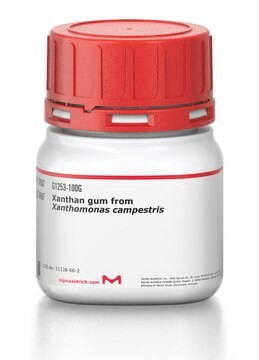30888
Gum arabic from acacia tree
spray dried, tested according to Ph. Eur.
Synonyme(s) :
Acacia gum
Se connecterpour consulter vos tarifs contractuels et ceux de votre entreprise/organisme
About This Item
Numéro CAS:
Numéro CE :
Numéro MDL:
Code UNSPSC :
12352201
Nomenclature NACRES :
NA.21
Produits recommandés
Source biologique
plant (acacia)
Agence
tested according to Ph. Eur.
Forme
powder
Solubilité
water: soluble
Température de stockage
room temp
Vous recherchez des produits similaires ? Visite Guide de comparaison des produits
Application
Acacia gum has been used as a surfactant in the development of hydrogels for tissue engineering applications. Acacia gum polymer has also been used to preserve microorganisms during sampling and storage.
Actions biochimiques/physiologiques
Gum arabic (GA) is reported to be a strong anti-oxidant and has shown protection against nephrotoxicity in mice by the generation of free radicals. GA also reduced the blood glucose concentration by initiating the release of insulin from the pancreatic β cells. It has hypolipidemic effect by increasing fecal bile acid and modification of lipid digestion. It is a potential therapeutic agent in hepatic and renal failures. It contains enzymes like oxidases, pectinases and peroxidases that act against microbes that cause tooth decay. Gum arabic is implicated in adverse effects like suppression of macrophage activation.
Autres remarques
Believed to be a branched polymer of galactose, rhamnose, arabinose, and glucuronic acid as the calcium, magnesium, and potassium salts with a mol. wt. of approx. 250,000.
To gain a comprehensive understanding of our extensive range of Polysaccharides for your research, we encourage you to visit our Carbohydrates Category page.
Code de la classe de stockage
11 - Combustible Solids
Classe de danger pour l'eau (WGK)
WGK 3
Point d'éclair (°F)
Not applicable
Point d'éclair (°C)
Not applicable
Faites votre choix parmi les versions les plus récentes :
Déjà en possession de ce produit ?
Retrouvez la documentation relative aux produits que vous avez récemment achetés dans la Bibliothèque de documents.
Les clients ont également consulté
K Fujiwara et al.
Journal of ethnopharmacology, 46(2), 107-114 (1995-05-01)
The effect of Xiao-Chai-Hu-Tang (Sho-saiko-to, TJ-9), the extract of a mixture of 7 herbs, on hepatic macrophage function was studied using rats. Hepatic macrophages were activated by injection of Corynebacterium parvum or 70% partial hepatectomy. Oral administration of TJ-9 for
Badreldin H Ali et al.
Food and chemical toxicology : an international journal published for the British Industrial Biological Research Association, 47(1), 1-8 (2008-08-02)
Gum arabic (GA) is a branched-chain, complex polysaccharide, either neutral or slightly acidic, found as a mixed calcium, magnesium and potassium salt of a polysaccharidic acid. The backbone is composed of 1,3-linked beta-D-galactopyranosyl units. The side chains are composed of
Iryna Sorokulova et al.
Journal of microbiological methods, 88(1), 140-146 (2011-11-19)
Stability of microbial cultures during sampling and storage is a vital issue in various fields of medicine, biotechnology, food science, and forensics. We have developed a unique bacterial preservation process involving a non-toxic, water-soluble acacia gum polymer that eliminates the
B H Ali
Renal failure, 26(1), 1-3 (2004-04-16)
Gum Arabic has recently been claimed to be effective in preventing gentamicin-induced acute renal failure in rats. The nephroprotection was suggested to be due to an anti-oxidant action by the gum Arabic. In the present work we tested whether treatment
Chengdong Ji et al.
Biomaterials, 32(36), 9719-9729 (2011-09-20)
The aim of this study was to develop a process to create highly porous three-dimensional (3D) chitosan hydrogels suitable for tissue engineering applications. Chitosan was crosslinked by glutaraldehyde (0.5 vol %) under high pressure CO(2) at 60 bar and 4
Notre équipe de scientifiques dispose d'une expérience dans tous les secteurs de la recherche, notamment en sciences de la vie, science des matériaux, synthèse chimique, chromatographie, analyse et dans de nombreux autres domaines..
Contacter notre Service technique








